Report: Understanding Child Behaviour Problems and Solutions
VerifiedAdded on 2020/05/16
|10
|2167
|84
Report
AI Summary
This report delves into the behavioral challenges of a child named Gemma, exploring strategies for intervention and support. It examines the importance of communication, adapting the physical and social environment, and the roles of family and external agencies in fostering positive behavior. The report highlights the application of the ecological systems theory to understand the interplay between the child and their environment, and discusses the impact of bullying and the need for a supportive classroom setting. It suggests interventions like storytelling and creative activities to address Gemma's anxiety and behavioral issues, emphasizing the importance of family involvement and adherence to ethical considerations and policy frameworks to promote the child's overall development and well-being. The report concludes by emphasizing the effectiveness of these interventions in helping Gemma adjust within the classroom environment.
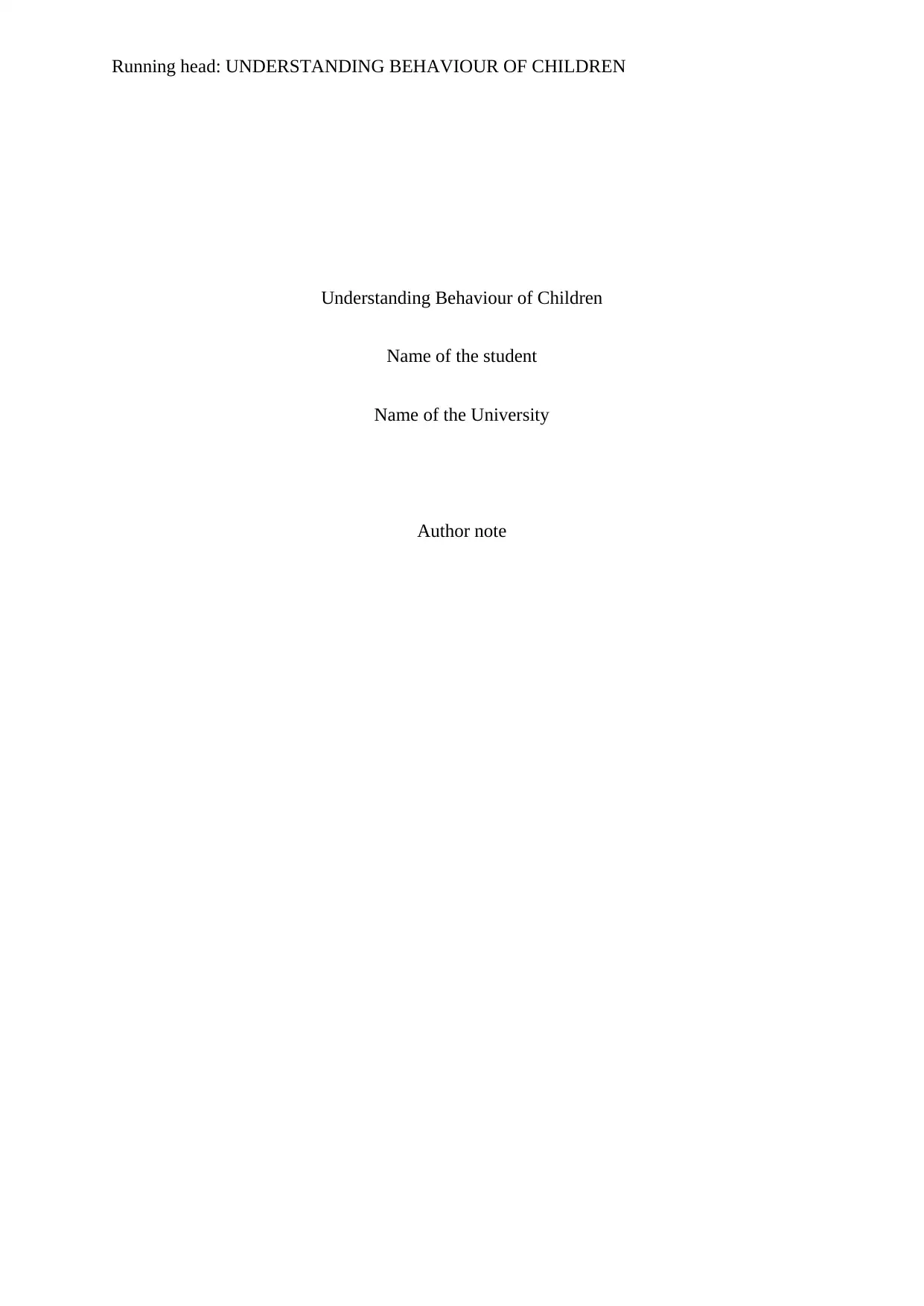
Running head: UNDERSTANDING BEHAVIOUR OF CHILDREN
Understanding Behaviour of Children
Name of the student
Name of the University
Author note
Understanding Behaviour of Children
Name of the student
Name of the University
Author note
Secure Best Marks with AI Grader
Need help grading? Try our AI Grader for instant feedback on your assignments.
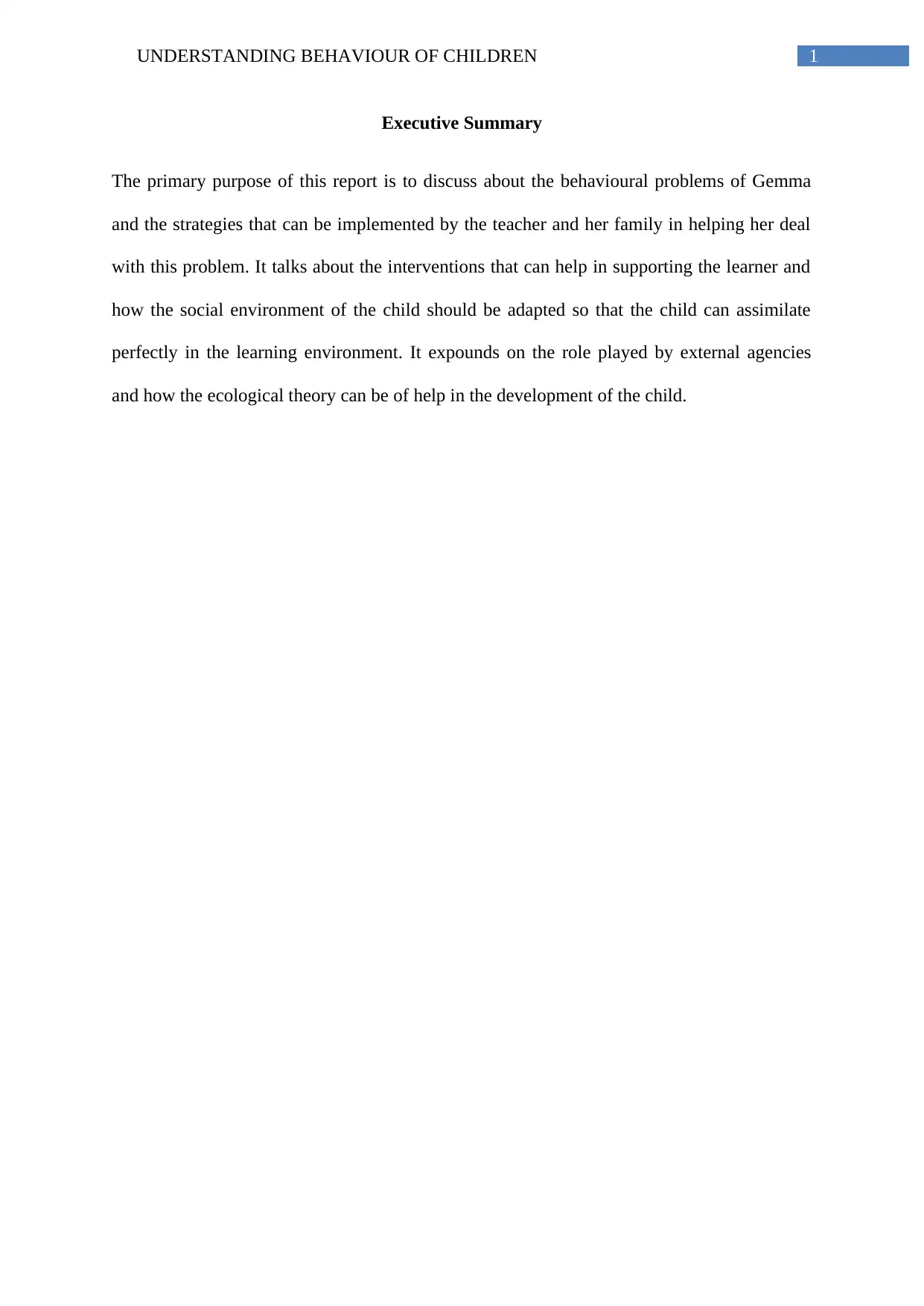
1UNDERSTANDING BEHAVIOUR OF CHILDREN
Executive Summary
The primary purpose of this report is to discuss about the behavioural problems of Gemma
and the strategies that can be implemented by the teacher and her family in helping her deal
with this problem. It talks about the interventions that can help in supporting the learner and
how the social environment of the child should be adapted so that the child can assimilate
perfectly in the learning environment. It expounds on the role played by external agencies
and how the ecological theory can be of help in the development of the child.
Executive Summary
The primary purpose of this report is to discuss about the behavioural problems of Gemma
and the strategies that can be implemented by the teacher and her family in helping her deal
with this problem. It talks about the interventions that can help in supporting the learner and
how the social environment of the child should be adapted so that the child can assimilate
perfectly in the learning environment. It expounds on the role played by external agencies
and how the ecological theory can be of help in the development of the child.
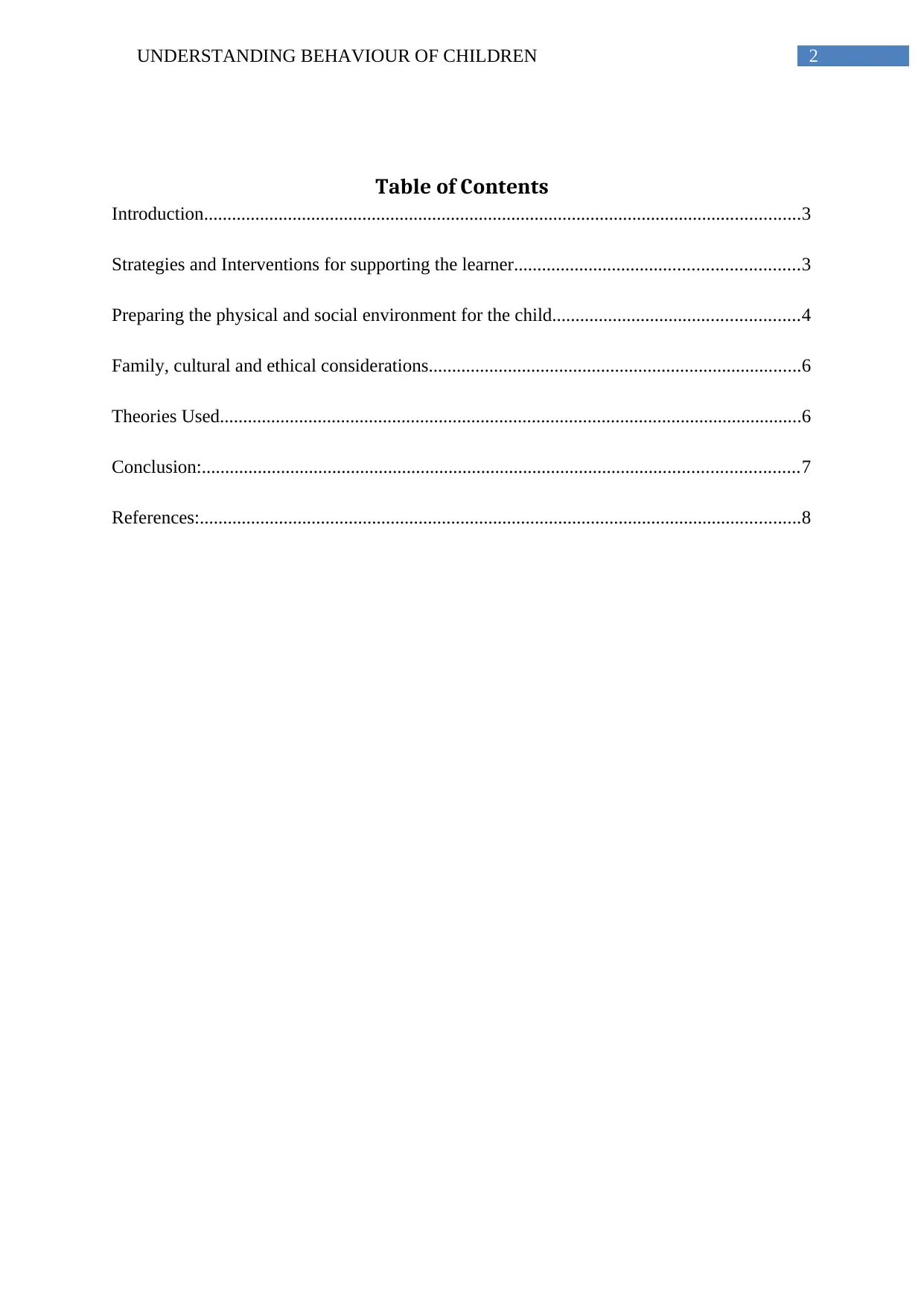
2UNDERSTANDING BEHAVIOUR OF CHILDREN
Table of Contents
Introduction................................................................................................................................3
Strategies and Interventions for supporting the learner.............................................................3
Preparing the physical and social environment for the child.....................................................4
Family, cultural and ethical considerations................................................................................6
Theories Used.............................................................................................................................6
Conclusion:................................................................................................................................7
References:.................................................................................................................................8
Table of Contents
Introduction................................................................................................................................3
Strategies and Interventions for supporting the learner.............................................................3
Preparing the physical and social environment for the child.....................................................4
Family, cultural and ethical considerations................................................................................6
Theories Used.............................................................................................................................6
Conclusion:................................................................................................................................7
References:.................................................................................................................................8
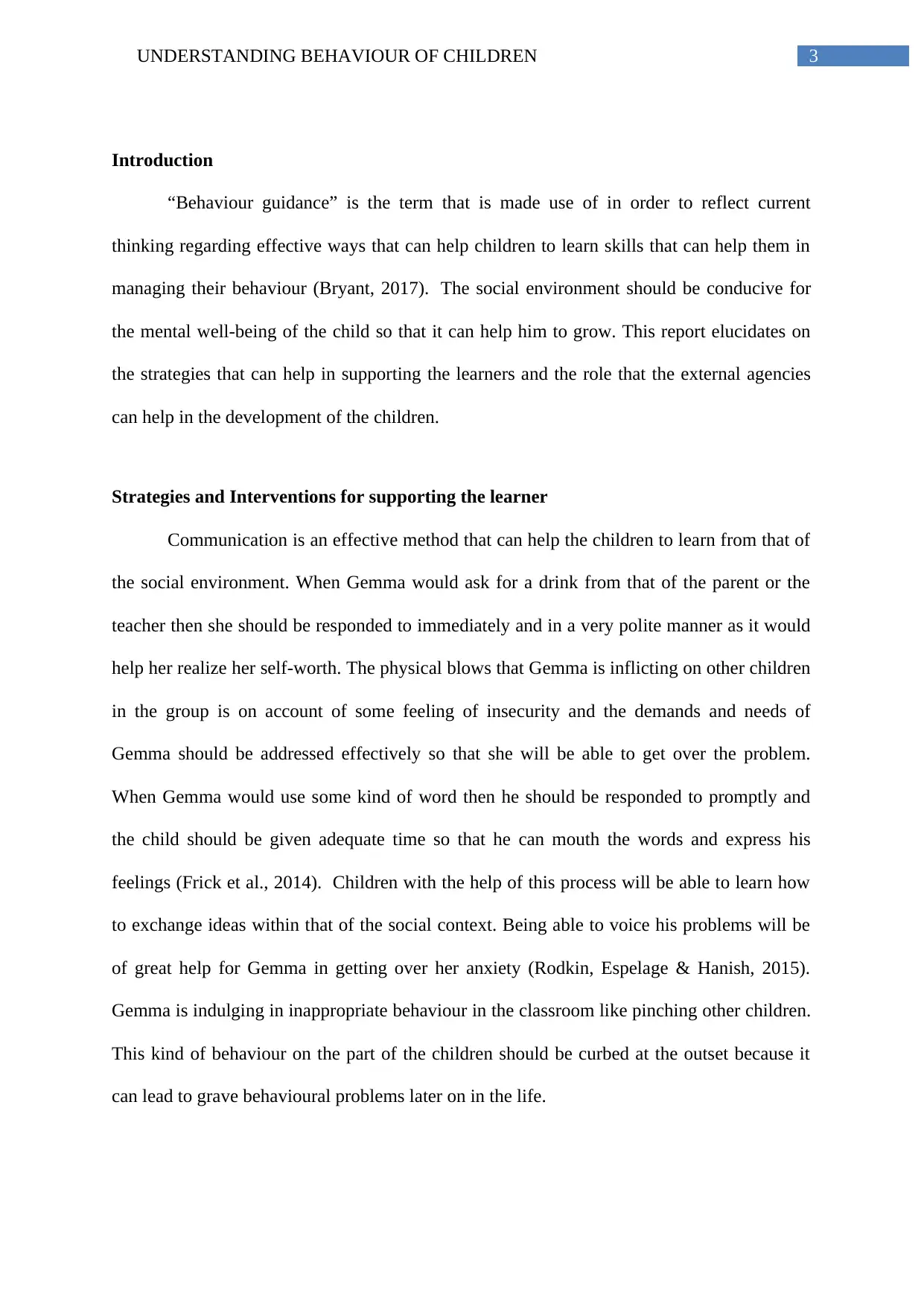
3UNDERSTANDING BEHAVIOUR OF CHILDREN
Introduction
“Behaviour guidance” is the term that is made use of in order to reflect current
thinking regarding effective ways that can help children to learn skills that can help them in
managing their behaviour (Bryant, 2017). The social environment should be conducive for
the mental well-being of the child so that it can help him to grow. This report elucidates on
the strategies that can help in supporting the learners and the role that the external agencies
can help in the development of the children.
Strategies and Interventions for supporting the learner
Communication is an effective method that can help the children to learn from that of
the social environment. When Gemma would ask for a drink from that of the parent or the
teacher then she should be responded to immediately and in a very polite manner as it would
help her realize her self-worth. The physical blows that Gemma is inflicting on other children
in the group is on account of some feeling of insecurity and the demands and needs of
Gemma should be addressed effectively so that she will be able to get over the problem.
When Gemma would use some kind of word then he should be responded to promptly and
the child should be given adequate time so that he can mouth the words and express his
feelings (Frick et al., 2014). Children with the help of this process will be able to learn how
to exchange ideas within that of the social context. Being able to voice his problems will be
of great help for Gemma in getting over her anxiety (Rodkin, Espelage & Hanish, 2015).
Gemma is indulging in inappropriate behaviour in the classroom like pinching other children.
This kind of behaviour on the part of the children should be curbed at the outset because it
can lead to grave behavioural problems later on in the life.
Introduction
“Behaviour guidance” is the term that is made use of in order to reflect current
thinking regarding effective ways that can help children to learn skills that can help them in
managing their behaviour (Bryant, 2017). The social environment should be conducive for
the mental well-being of the child so that it can help him to grow. This report elucidates on
the strategies that can help in supporting the learners and the role that the external agencies
can help in the development of the children.
Strategies and Interventions for supporting the learner
Communication is an effective method that can help the children to learn from that of
the social environment. When Gemma would ask for a drink from that of the parent or the
teacher then she should be responded to immediately and in a very polite manner as it would
help her realize her self-worth. The physical blows that Gemma is inflicting on other children
in the group is on account of some feeling of insecurity and the demands and needs of
Gemma should be addressed effectively so that she will be able to get over the problem.
When Gemma would use some kind of word then he should be responded to promptly and
the child should be given adequate time so that he can mouth the words and express his
feelings (Frick et al., 2014). Children with the help of this process will be able to learn how
to exchange ideas within that of the social context. Being able to voice his problems will be
of great help for Gemma in getting over her anxiety (Rodkin, Espelage & Hanish, 2015).
Gemma is indulging in inappropriate behaviour in the classroom like pinching other children.
This kind of behaviour on the part of the children should be curbed at the outset because it
can lead to grave behavioural problems later on in the life.
Secure Best Marks with AI Grader
Need help grading? Try our AI Grader for instant feedback on your assignments.
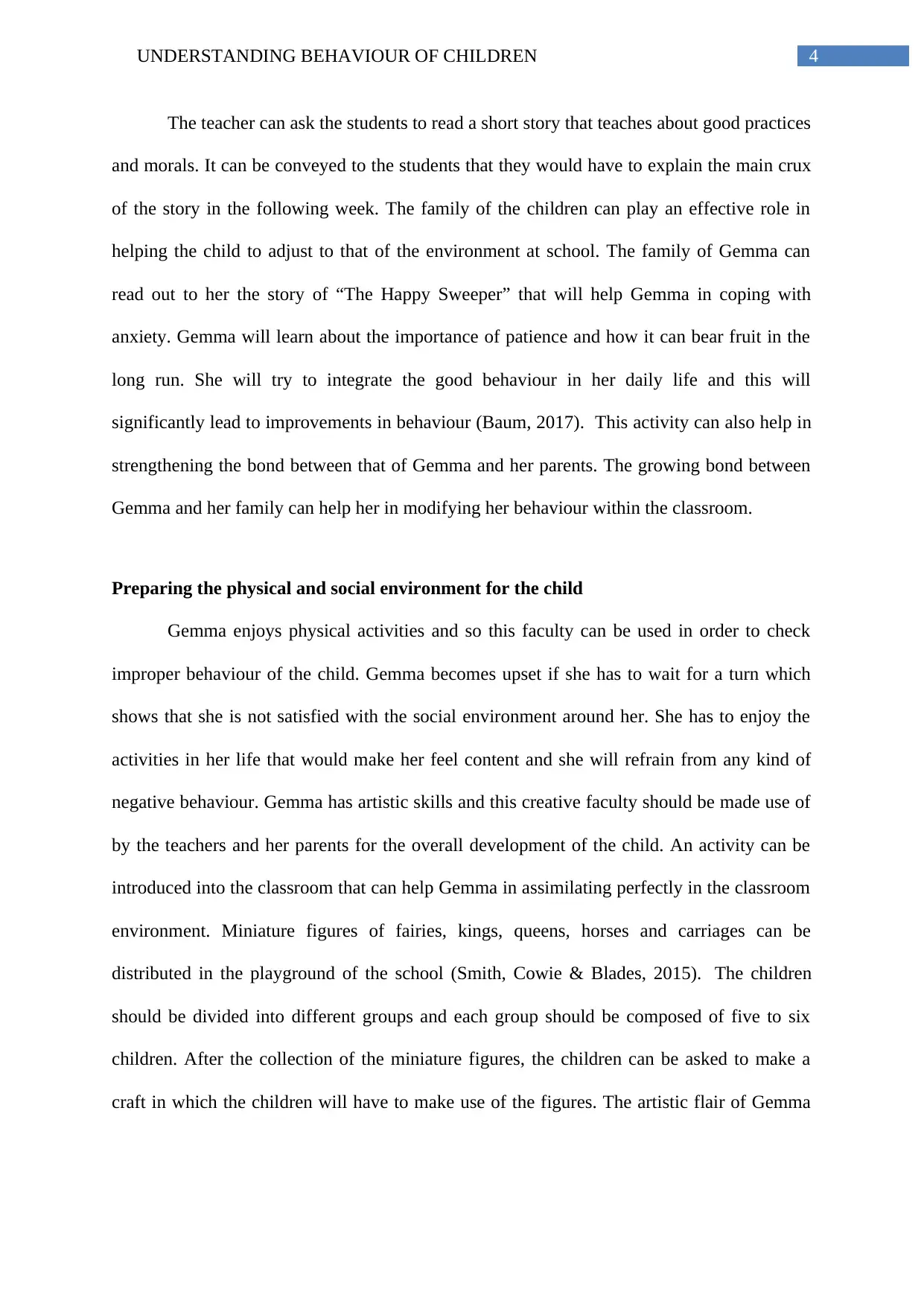
4UNDERSTANDING BEHAVIOUR OF CHILDREN
The teacher can ask the students to read a short story that teaches about good practices
and morals. It can be conveyed to the students that they would have to explain the main crux
of the story in the following week. The family of the children can play an effective role in
helping the child to adjust to that of the environment at school. The family of Gemma can
read out to her the story of “The Happy Sweeper” that will help Gemma in coping with
anxiety. Gemma will learn about the importance of patience and how it can bear fruit in the
long run. She will try to integrate the good behaviour in her daily life and this will
significantly lead to improvements in behaviour (Baum, 2017). This activity can also help in
strengthening the bond between that of Gemma and her parents. The growing bond between
Gemma and her family can help her in modifying her behaviour within the classroom.
Preparing the physical and social environment for the child
Gemma enjoys physical activities and so this faculty can be used in order to check
improper behaviour of the child. Gemma becomes upset if she has to wait for a turn which
shows that she is not satisfied with the social environment around her. She has to enjoy the
activities in her life that would make her feel content and she will refrain from any kind of
negative behaviour. Gemma has artistic skills and this creative faculty should be made use of
by the teachers and her parents for the overall development of the child. An activity can be
introduced into the classroom that can help Gemma in assimilating perfectly in the classroom
environment. Miniature figures of fairies, kings, queens, horses and carriages can be
distributed in the playground of the school (Smith, Cowie & Blades, 2015). The children
should be divided into different groups and each group should be composed of five to six
children. After the collection of the miniature figures, the children can be asked to make a
craft in which the children will have to make use of the figures. The artistic flair of Gemma
The teacher can ask the students to read a short story that teaches about good practices
and morals. It can be conveyed to the students that they would have to explain the main crux
of the story in the following week. The family of the children can play an effective role in
helping the child to adjust to that of the environment at school. The family of Gemma can
read out to her the story of “The Happy Sweeper” that will help Gemma in coping with
anxiety. Gemma will learn about the importance of patience and how it can bear fruit in the
long run. She will try to integrate the good behaviour in her daily life and this will
significantly lead to improvements in behaviour (Baum, 2017). This activity can also help in
strengthening the bond between that of Gemma and her parents. The growing bond between
Gemma and her family can help her in modifying her behaviour within the classroom.
Preparing the physical and social environment for the child
Gemma enjoys physical activities and so this faculty can be used in order to check
improper behaviour of the child. Gemma becomes upset if she has to wait for a turn which
shows that she is not satisfied with the social environment around her. She has to enjoy the
activities in her life that would make her feel content and she will refrain from any kind of
negative behaviour. Gemma has artistic skills and this creative faculty should be made use of
by the teachers and her parents for the overall development of the child. An activity can be
introduced into the classroom that can help Gemma in assimilating perfectly in the classroom
environment. Miniature figures of fairies, kings, queens, horses and carriages can be
distributed in the playground of the school (Smith, Cowie & Blades, 2015). The children
should be divided into different groups and each group should be composed of five to six
children. After the collection of the miniature figures, the children can be asked to make a
craft in which the children will have to make use of the figures. The artistic flair of Gemma
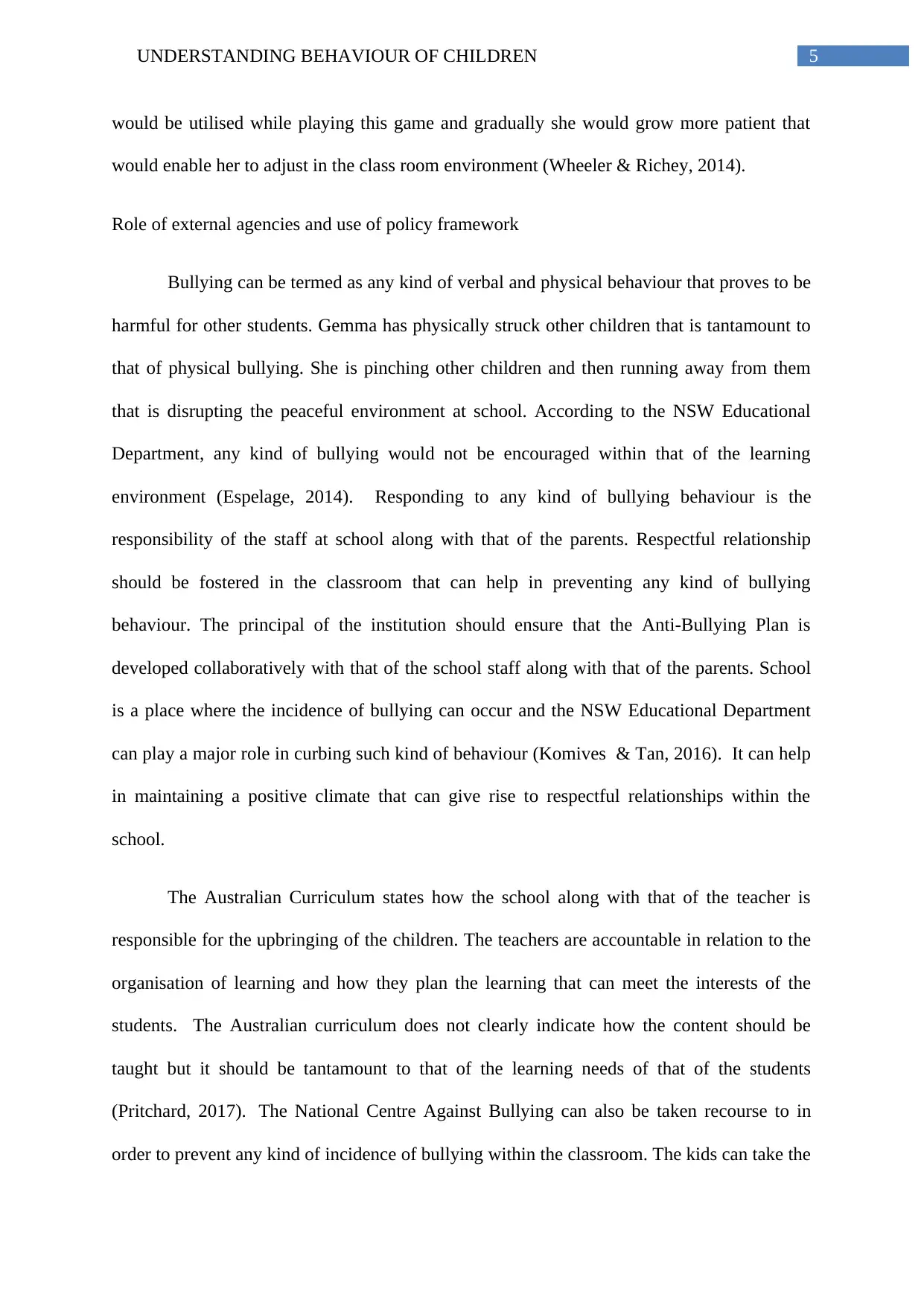
5UNDERSTANDING BEHAVIOUR OF CHILDREN
would be utilised while playing this game and gradually she would grow more patient that
would enable her to adjust in the class room environment (Wheeler & Richey, 2014).
Role of external agencies and use of policy framework
Bullying can be termed as any kind of verbal and physical behaviour that proves to be
harmful for other students. Gemma has physically struck other children that is tantamount to
that of physical bullying. She is pinching other children and then running away from them
that is disrupting the peaceful environment at school. According to the NSW Educational
Department, any kind of bullying would not be encouraged within that of the learning
environment (Espelage, 2014). Responding to any kind of bullying behaviour is the
responsibility of the staff at school along with that of the parents. Respectful relationship
should be fostered in the classroom that can help in preventing any kind of bullying
behaviour. The principal of the institution should ensure that the Anti-Bullying Plan is
developed collaboratively with that of the school staff along with that of the parents. School
is a place where the incidence of bullying can occur and the NSW Educational Department
can play a major role in curbing such kind of behaviour (Komives & Tan, 2016). It can help
in maintaining a positive climate that can give rise to respectful relationships within the
school.
The Australian Curriculum states how the school along with that of the teacher is
responsible for the upbringing of the children. The teachers are accountable in relation to the
organisation of learning and how they plan the learning that can meet the interests of the
students. The Australian curriculum does not clearly indicate how the content should be
taught but it should be tantamount to that of the learning needs of that of the students
(Pritchard, 2017). The National Centre Against Bullying can also be taken recourse to in
order to prevent any kind of incidence of bullying within the classroom. The kids can take the
would be utilised while playing this game and gradually she would grow more patient that
would enable her to adjust in the class room environment (Wheeler & Richey, 2014).
Role of external agencies and use of policy framework
Bullying can be termed as any kind of verbal and physical behaviour that proves to be
harmful for other students. Gemma has physically struck other children that is tantamount to
that of physical bullying. She is pinching other children and then running away from them
that is disrupting the peaceful environment at school. According to the NSW Educational
Department, any kind of bullying would not be encouraged within that of the learning
environment (Espelage, 2014). Responding to any kind of bullying behaviour is the
responsibility of the staff at school along with that of the parents. Respectful relationship
should be fostered in the classroom that can help in preventing any kind of bullying
behaviour. The principal of the institution should ensure that the Anti-Bullying Plan is
developed collaboratively with that of the school staff along with that of the parents. School
is a place where the incidence of bullying can occur and the NSW Educational Department
can play a major role in curbing such kind of behaviour (Komives & Tan, 2016). It can help
in maintaining a positive climate that can give rise to respectful relationships within the
school.
The Australian Curriculum states how the school along with that of the teacher is
responsible for the upbringing of the children. The teachers are accountable in relation to the
organisation of learning and how they plan the learning that can meet the interests of the
students. The Australian curriculum does not clearly indicate how the content should be
taught but it should be tantamount to that of the learning needs of that of the students
(Pritchard, 2017). The National Centre Against Bullying can also be taken recourse to in
order to prevent any kind of incidence of bullying within the classroom. The kids can take the
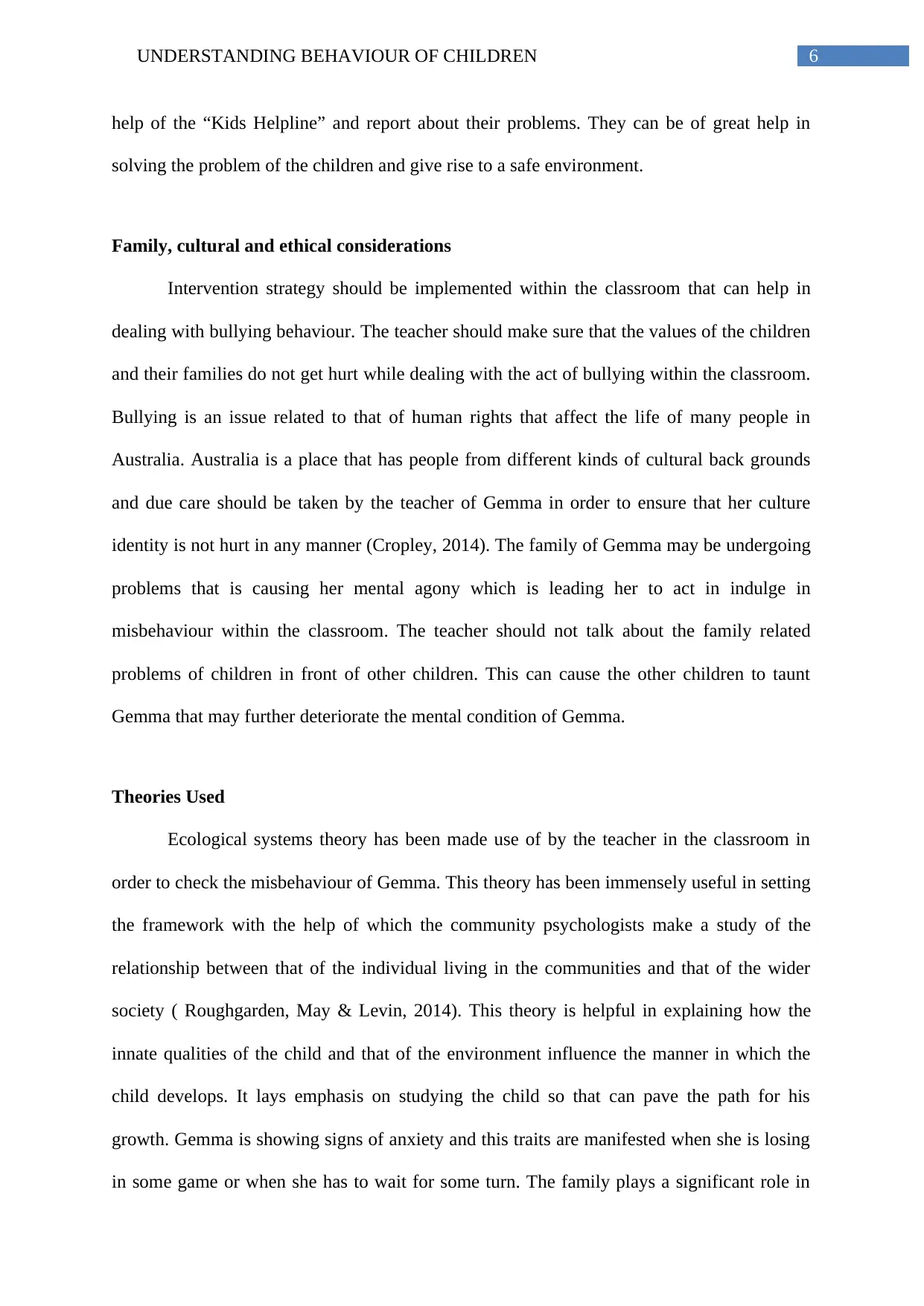
6UNDERSTANDING BEHAVIOUR OF CHILDREN
help of the “Kids Helpline” and report about their problems. They can be of great help in
solving the problem of the children and give rise to a safe environment.
Family, cultural and ethical considerations
Intervention strategy should be implemented within the classroom that can help in
dealing with bullying behaviour. The teacher should make sure that the values of the children
and their families do not get hurt while dealing with the act of bullying within the classroom.
Bullying is an issue related to that of human rights that affect the life of many people in
Australia. Australia is a place that has people from different kinds of cultural back grounds
and due care should be taken by the teacher of Gemma in order to ensure that her culture
identity is not hurt in any manner (Cropley, 2014). The family of Gemma may be undergoing
problems that is causing her mental agony which is leading her to act in indulge in
misbehaviour within the classroom. The teacher should not talk about the family related
problems of children in front of other children. This can cause the other children to taunt
Gemma that may further deteriorate the mental condition of Gemma.
Theories Used
Ecological systems theory has been made use of by the teacher in the classroom in
order to check the misbehaviour of Gemma. This theory has been immensely useful in setting
the framework with the help of which the community psychologists make a study of the
relationship between that of the individual living in the communities and that of the wider
society ( Roughgarden, May & Levin, 2014). This theory is helpful in explaining how the
innate qualities of the child and that of the environment influence the manner in which the
child develops. It lays emphasis on studying the child so that can pave the path for his
growth. Gemma is showing signs of anxiety and this traits are manifested when she is losing
in some game or when she has to wait for some turn. The family plays a significant role in
help of the “Kids Helpline” and report about their problems. They can be of great help in
solving the problem of the children and give rise to a safe environment.
Family, cultural and ethical considerations
Intervention strategy should be implemented within the classroom that can help in
dealing with bullying behaviour. The teacher should make sure that the values of the children
and their families do not get hurt while dealing with the act of bullying within the classroom.
Bullying is an issue related to that of human rights that affect the life of many people in
Australia. Australia is a place that has people from different kinds of cultural back grounds
and due care should be taken by the teacher of Gemma in order to ensure that her culture
identity is not hurt in any manner (Cropley, 2014). The family of Gemma may be undergoing
problems that is causing her mental agony which is leading her to act in indulge in
misbehaviour within the classroom. The teacher should not talk about the family related
problems of children in front of other children. This can cause the other children to taunt
Gemma that may further deteriorate the mental condition of Gemma.
Theories Used
Ecological systems theory has been made use of by the teacher in the classroom in
order to check the misbehaviour of Gemma. This theory has been immensely useful in setting
the framework with the help of which the community psychologists make a study of the
relationship between that of the individual living in the communities and that of the wider
society ( Roughgarden, May & Levin, 2014). This theory is helpful in explaining how the
innate qualities of the child and that of the environment influence the manner in which the
child develops. It lays emphasis on studying the child so that can pave the path for his
growth. Gemma is showing signs of anxiety and this traits are manifested when she is losing
in some game or when she has to wait for some turn. The family plays a significant role in
Paraphrase This Document
Need a fresh take? Get an instant paraphrase of this document with our AI Paraphraser
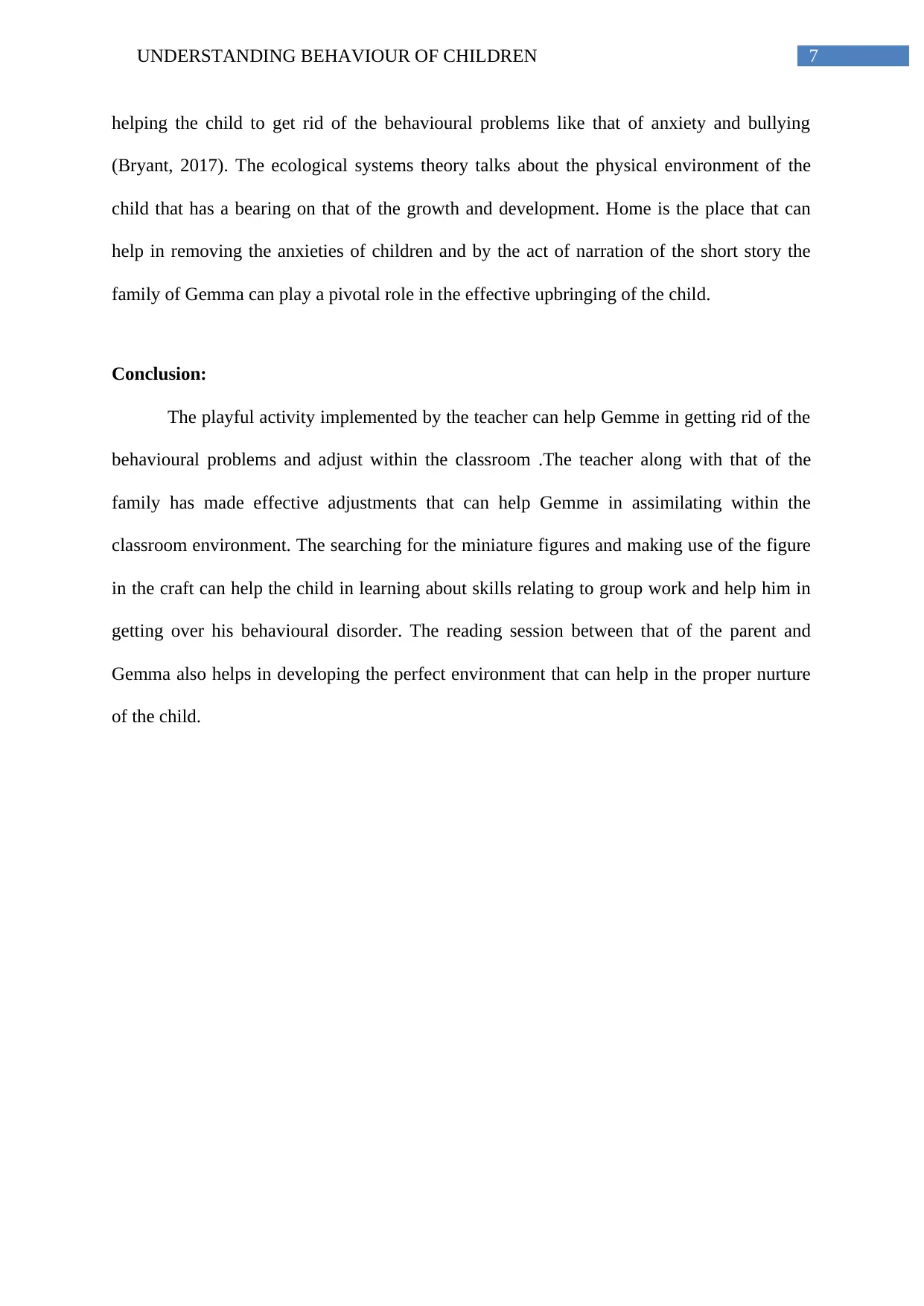
7UNDERSTANDING BEHAVIOUR OF CHILDREN
helping the child to get rid of the behavioural problems like that of anxiety and bullying
(Bryant, 2017). The ecological systems theory talks about the physical environment of the
child that has a bearing on that of the growth and development. Home is the place that can
help in removing the anxieties of children and by the act of narration of the short story the
family of Gemma can play a pivotal role in the effective upbringing of the child.
Conclusion:
The playful activity implemented by the teacher can help Gemme in getting rid of the
behavioural problems and adjust within the classroom .The teacher along with that of the
family has made effective adjustments that can help Gemme in assimilating within the
classroom environment. The searching for the miniature figures and making use of the figure
in the craft can help the child in learning about skills relating to group work and help him in
getting over his behavioural disorder. The reading session between that of the parent and
Gemma also helps in developing the perfect environment that can help in the proper nurture
of the child.
helping the child to get rid of the behavioural problems like that of anxiety and bullying
(Bryant, 2017). The ecological systems theory talks about the physical environment of the
child that has a bearing on that of the growth and development. Home is the place that can
help in removing the anxieties of children and by the act of narration of the short story the
family of Gemma can play a pivotal role in the effective upbringing of the child.
Conclusion:
The playful activity implemented by the teacher can help Gemme in getting rid of the
behavioural problems and adjust within the classroom .The teacher along with that of the
family has made effective adjustments that can help Gemme in assimilating within the
classroom environment. The searching for the miniature figures and making use of the figure
in the craft can help the child in learning about skills relating to group work and help him in
getting over his behavioural disorder. The reading session between that of the parent and
Gemma also helps in developing the perfect environment that can help in the proper nurture
of the child.
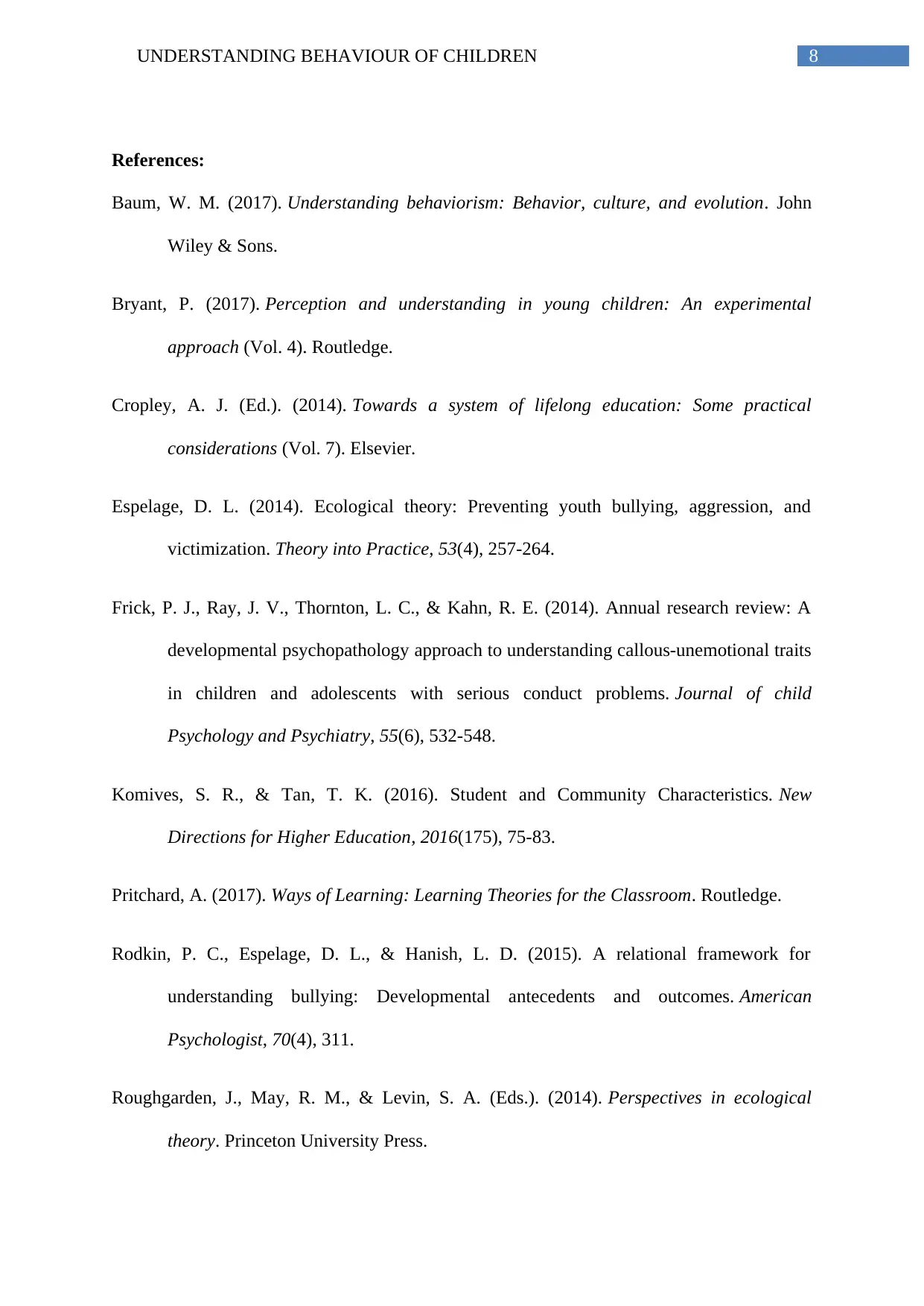
8UNDERSTANDING BEHAVIOUR OF CHILDREN
References:
Baum, W. M. (2017). Understanding behaviorism: Behavior, culture, and evolution. John
Wiley & Sons.
Bryant, P. (2017). Perception and understanding in young children: An experimental
approach (Vol. 4). Routledge.
Cropley, A. J. (Ed.). (2014). Towards a system of lifelong education: Some practical
considerations (Vol. 7). Elsevier.
Espelage, D. L. (2014). Ecological theory: Preventing youth bullying, aggression, and
victimization. Theory into Practice, 53(4), 257-264.
Frick, P. J., Ray, J. V., Thornton, L. C., & Kahn, R. E. (2014). Annual research review: A
developmental psychopathology approach to understanding callous‐unemotional traits
in children and adolescents with serious conduct problems. Journal of child
Psychology and Psychiatry, 55(6), 532-548.
Komives, S. R., & Tan, T. K. (2016). Student and Community Characteristics. New
Directions for Higher Education, 2016(175), 75-83.
Pritchard, A. (2017). Ways of Learning: Learning Theories for the Classroom. Routledge.
Rodkin, P. C., Espelage, D. L., & Hanish, L. D. (2015). A relational framework for
understanding bullying: Developmental antecedents and outcomes. American
Psychologist, 70(4), 311.
Roughgarden, J., May, R. M., & Levin, S. A. (Eds.). (2014). Perspectives in ecological
theory. Princeton University Press.
References:
Baum, W. M. (2017). Understanding behaviorism: Behavior, culture, and evolution. John
Wiley & Sons.
Bryant, P. (2017). Perception and understanding in young children: An experimental
approach (Vol. 4). Routledge.
Cropley, A. J. (Ed.). (2014). Towards a system of lifelong education: Some practical
considerations (Vol. 7). Elsevier.
Espelage, D. L. (2014). Ecological theory: Preventing youth bullying, aggression, and
victimization. Theory into Practice, 53(4), 257-264.
Frick, P. J., Ray, J. V., Thornton, L. C., & Kahn, R. E. (2014). Annual research review: A
developmental psychopathology approach to understanding callous‐unemotional traits
in children and adolescents with serious conduct problems. Journal of child
Psychology and Psychiatry, 55(6), 532-548.
Komives, S. R., & Tan, T. K. (2016). Student and Community Characteristics. New
Directions for Higher Education, 2016(175), 75-83.
Pritchard, A. (2017). Ways of Learning: Learning Theories for the Classroom. Routledge.
Rodkin, P. C., Espelage, D. L., & Hanish, L. D. (2015). A relational framework for
understanding bullying: Developmental antecedents and outcomes. American
Psychologist, 70(4), 311.
Roughgarden, J., May, R. M., & Levin, S. A. (Eds.). (2014). Perspectives in ecological
theory. Princeton University Press.
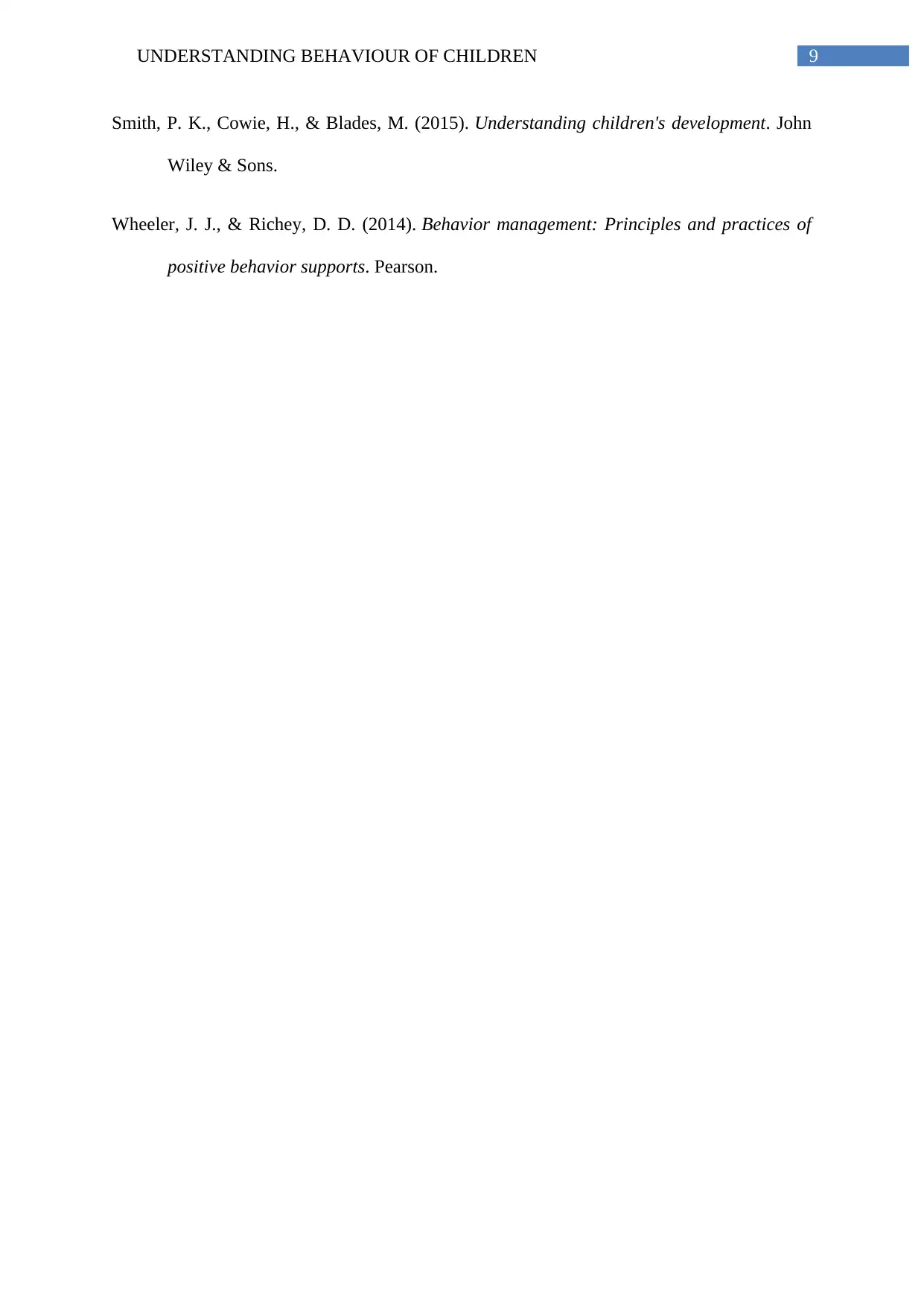
9UNDERSTANDING BEHAVIOUR OF CHILDREN
Smith, P. K., Cowie, H., & Blades, M. (2015). Understanding children's development. John
Wiley & Sons.
Wheeler, J. J., & Richey, D. D. (2014). Behavior management: Principles and practices of
positive behavior supports. Pearson.
Smith, P. K., Cowie, H., & Blades, M. (2015). Understanding children's development. John
Wiley & Sons.
Wheeler, J. J., & Richey, D. D. (2014). Behavior management: Principles and practices of
positive behavior supports. Pearson.
1 out of 10
Related Documents
Your All-in-One AI-Powered Toolkit for Academic Success.
+13062052269
info@desklib.com
Available 24*7 on WhatsApp / Email
![[object Object]](/_next/static/media/star-bottom.7253800d.svg)
Unlock your academic potential
© 2024 | Zucol Services PVT LTD | All rights reserved.





